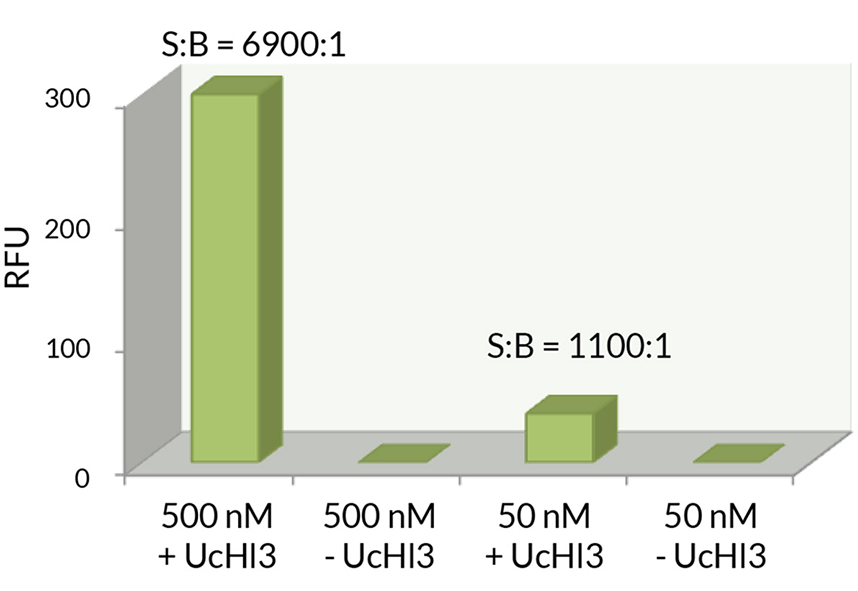Ubiquitin (human) (rec.) (Rhodamine 110)
Product Code:
SBB-PS0001
SBB-PS0001
Regulatory Status:
RUO
RUO
Target Species:
Human
Human
Shipping:
Dry Ice
Dry Ice
Storage:
-80C
-80C
No additional charges, what you see is what you pay! *
| Code | Size | Price |
|---|
| SBB-PS0001-C050 | 50 ug | £342.00 |
Quantity:
Prices exclude any Taxes / VAT
Stay in control of your spending. These prices have no additional charges, not even shipping!
* Rare exceptions are clearly labelled (only 0.14% of items!).
* Rare exceptions are clearly labelled (only 0.14% of items!).
Multibuy discounts available! Contact us to find what you can save.
This product comes from: Switzerland.
Typical lead time: 10-14 working days.
Contact us for more accurate information.
Typical lead time: 10-14 working days.
Contact us for more accurate information.
- Further Information
- Documents
- Show All
Further Information
Alternate Names/Synonyms:
UBB; Ubiquitin B
Concentration:
Lot dependent.
EClass:
32160000
Form (Short):
liquid
Formulation:
Liquid. In 50mM MES pH 6.0.
Handling Advice:
Aliquot to avoid freeze/thaw cycles.Protect from light.
Labels - Conjugates:
Rhodamine
Long Description:
Protein. Human ubiquitin (aa1-76)conjugated at the C-terminus to a quenched Rhodamine 110 dye. Source: E. coli. Formulation: Liquid. In 50mM MES pH 6.0. Purity: >99% (LCMS). Ubiquitin is a 76 amino acid post-translational modifier expressed throughout all tissues in eukaryotic organisms. The many roles of ubiquitin modification include proteasomal degradation, signal transduction, inflammatory response and DNA damage repair. Ubiquitin modification occurs through a pyramidal cascade of an E1 activating enzyme, E2 conjugating enzymes and an E3 ubiquitin ligase. This enzymatic cascade results in modification of a epsilon-amine of a lysine residue on a substrate protein. Substrates may either be mono- or poly-ubiquitinated by M1, K6, 11, 27, 29, 33, 48 or 63 linkages. Removal of ubiquitin from a substrate protein occurs via deconjugating enzymes, of which there are nearly 100 known enzymes with various specificities.
Molecular Weight:
~9kDa
NCBI, Uniprot Number:
P0CG47
Package Type:
Plastic Vial
Product Description:
Ubiquitin is a 76 amino acid post-translational modifier expressed throughout all tissues in eukaryotic organisms. The many roles of ubiquitin modification include proteasomal degradation, signal transduction, inflammatory response and DNA damage repair. Ubiquitin modification occurs through a pyramidal cascade of an E1 activating enzyme, E2 conjugating enzymes and an E3 ubiquitin ligase. This enzymatic cascade results in modification of a epsilon-amine of a lysine residue on a substrate protein. Substrates may either be mono- or poly-ubiquitinated by M1, K6, 11, 27, 29, 33, 48 or 63 linkages. Removal of ubiquitin from a substrate protein occurs via deconjugating enzymes, of which there are nearly 100 known enzymes with various specificities.
Purity:
>99% (LCMS)
Sequence:
Human ubiquitin (aa1-76) (Accession Nr. P0CG47 http://www.ncbi.nlm.nih.gov/protein/P0CG47 ) conjugated at the C-terminus to a quenched Rhodamine 110 dye.
Source / Host:
E. coli
Transportation:
Non-hazardous
UNSPSC Category:
Other Proteins
UNSPSC Number:
12352202
Use & Stability:
Stable for at least 1 year after receipt when stored at -80°C.



